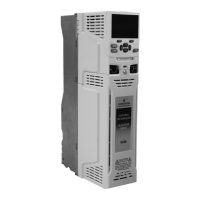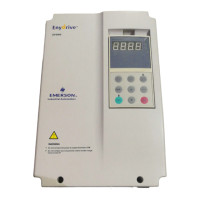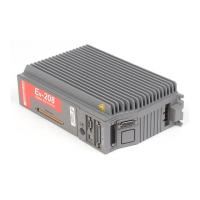Safety
information
Product
information
Mechanical
installation
Electrical
installation
Getting
started
User Menu A Commissioning
Advanced
Parameters
Diagnostics Optimization CT MODBUS RTU Technical Data
E300 Design Guide 349
Issue Number: 1
The speed error is the difference between the final Final Speed Reference (J50) and the Drive Encoder Speed Feedback (J51), and does not include
the effect of the differential term in the speed controller feedback branch.
The output of the speed regulator is a torque demand given as a percentage of rated motor torque. It should be noted that this will be modified to take
into account in the level of motor flux if field weakening is active before it is converted into the Final Current Reference (J20).
The diagram below shows a generalized representation of the speed controller. The controller includes a feed forward proportional gain (Kp), a feed
forward integral gain (Ki), and a differential feedback gain (Kd). The description here refers to the first set of gains for motor map 1 (Final Speed Loop
Kp (J33) and Final Speed Loop Ki (J34).
Proportional gain (Kp) - Final Speed Loop Kp (J33)
If Kp is non-zero and Ki is zero the controller will only have a proportional term, and there must be a speed error to produce a torque reference.
Therefore, as the motor load increases there will be a difference between the reference and actual speeds. This effect, called regulation, depends on
the level of the proportional gain, the higher the gain the smaller the speed error for a given load. If the proportional gain is too high either the acoustic
noise produced due to speed feedback quantisation becomes unacceptable, or the closed-loop stability limit is reached.
Integral gain (Ki) - Final Speed Loop Ki (J34)
The integral gain is provided to prevent speed regulation. The error is accumulated over a period of time and used to produce the necessary torque
reference without any speed error. Increasing the integral gain reduces the time taken for the speed to reach the correct level and increases the
stiffness of the system, i.e. it reduces the positional displacement produced by applying a load torque to the motor. Unfortunately increasing the
integral gain also reduces the system damping giving overshoot after a transient.
J31 Speed Error
Mode RFC-A, RFC-S
Minimum −VM_SPEED Maximum VM_SPEED
Default Units
Type 32 Bit Volatile Update Rate 4 ms write
Display Format Standard Decimal Places 1
Coding RO, FI, VM, ND, NC, PT
J32 Speed Loop Output
Mode RFC-A, RFC-S
Minimum −VM_TORQUE_CURRENT Maximum VM_TORQUE_CURRENT
Default Units %
Type 16 Bit Volatile Update Rate 4 ms write
Display Format Standard Decimal Places 1
Coding RO, FI, VM, ND, NC, PT
J33 Final Speed Loop Kp
Mode RFC-A, RFC-S
Minimum 0.0000 Maximum 200.0000
Default 0.0300 Units s/rad
Type 32 Bit User Save Update Rate 4 ms write
Display Format Standard Decimal Places 4
Coding RW
_
+
+
+Kp
Ki / s
Speed reference(w*) Torque reference (Te*)
Speed feedback(w)
Speed controller

